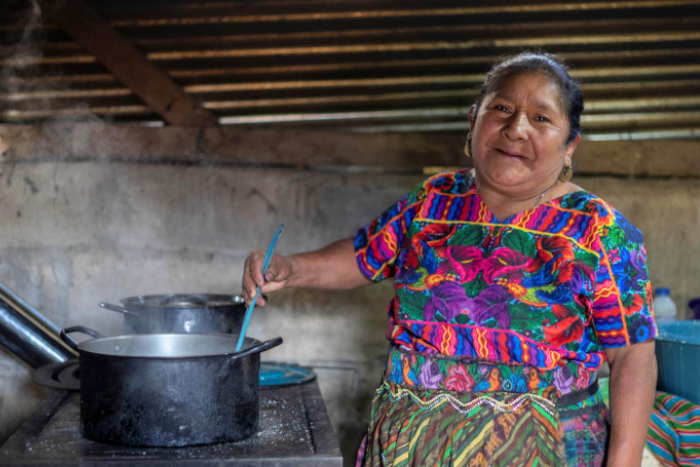Women’s access to clean cooking equipment is enhanced by subsidies enabled by finance from carbon markets, which can be scaled up with the operationalisation of global carbon markets under Article 6
Around the world and especially in the Global South, many households rely on using wood as firewood to cook their meals. Due to the gender-based roles that are prevalent in most societies, it is women who bear the brunt of not just inhaling the toxic fumes while cooking food but also the burden of collecting wood falls categorically on their shoulders.
This is where carbon markets are bringing about a change for many women.
“Carbon financing enables developers like us to trade in high value credits, where we sell Internationally Transferred Mitigation Outcomes (ITMOs) created in Africa at a very good price for buyers in the Global North. This means that we subsidise the cost of our products. We have been able to reduce the cost of our cookstoves by up to 40% because of carbon markets,” says Caroline Amollo, Director of Corporate Affairs, BURN, which works on making clean cooking accessible to countries in Africa.
Amollo says that the majority of the end users of these products are women—who benefit significantly by switching to clean cooking methods. Due to subsidies enabled by carbon markets, more women have access to cleaner cooking products as the barrier of a lack of purchasing power is removed.
The UN’s Food and Agriculture Organization (FAO) says that worldwide, around 2.4 billion people still cook using fuels such as wood and kerosene, mostly in Africa. In India, some studies say that over a third of households still relied on firewood as their primary source of cooking fuel in 2020-21.
“Apart from developing respiratory problems like asthma and lung cancer, the time that women spend on collecting the wood and keeping the fire going while cooking is a lot,” said Yanna Gruel, General Manager, Microsol—who works with communities in Peru, Mexico, Guatemala and other Latin American countries to make cleaner cooking accessible. Microsol provides stoves for free to communities to switch to clean cooking methods. Gruel says it has been possible due to carbon markets. Currently, operating under voluntary carbon markets with their projects certified by Gold Standard, Microsol injects the returns from carbon market to maintain the cookstoves in the communities, repair or replace them.
“With accessible cleaner cooking options, that time can be used in other activities that they like, including resting, spending time with their families, helping with their child’s education, etc. and improve their health and life overall and so of their family,” adds Gruel.
As Delhi struggles with dangerous outdoor air quality levels these days, it is important to note using unclean cooking leads to all-year-round poor air quality indoors.

Loopholes to fix
A report by the Centre for Science and Environment (CSE) that looked into the voluntary carbon market in India says around one-fifth of over 1,200 cookstove projects registered or under various stages of development with Verra and Gold Standard are in India.
Earlier this year, India expanded its list of eligible projects under the Paris Agreement’s Article 6 mechanisms to include clean cooking initiatives. This addition joined the initial 13 activities under Article 6.2.
The CSE report also featured a study which said that clean household device projects had a 50% year on year growth—expansion of developers portfolio—in Africa and India.
However, the report also finds that a lot of times communities are not informed when they sign over a consent form during installation of cooking stoves, transferring carbon rights to the developers and companies involved.
Other issues like lack of evidence of robust monitoring, over crediting gains of removal, lack of an organised marketplace to monitor the price of carbon credit for improved cookstoves, among others, plague the sector.
Therefore, a lot needs to be set right for these markets to function in a way that benefits the communities, who are actually making the mitigation move.
Hope renewed
More carbon markets can now potentially open up which can provide more finance for such initiatves, significantly improving health and lives of women around the world.
In the first week of COP29, negotiators reached consensus on standards for the creation of carbon credits under Article 6.4 of the Paris Agreement. While carbon markets are already functioning bilaterally under Article 6.2, the latest developments at COP29 can make the process for a centralised global carbon offset market more transparent and ensure that the international carbon market operates with integrity under the supervision of the United Nations.
“It appears that the process for clauses like authorisation will be common for both Article 6.4 and Article 6.2. The methodologies under 6.4 will be reviewed by the Supervisory Body. So, if a country submits a methodology under clean cooking, the Supervisory Body will see the provisions for criteria like additionality and permanence, among others. However, even if the Supervisory Body passes the methodology, the final decision related to implementation of the same lies with the Parties,” explains Vaibhav Chaturvedi, Senior Fellow, Council on Energy, Environment and Water(CEEW).
Simon Stiell, UN Climate Change Executive Secretary, when Parties at COP29 agreed on international carbon market standards, said, “There’s more work to do, but this is a good start – the product of over 10 years of work within the process. We are a long way from halving emissions this decade, but wins on carbon markets here at COP29 will help us get back in that race.”
About The Author
You may also like
India says it won’t rely on global climate or pollution rankings to shape policies
COP30 Kicks Off With Hard Talks on Money, Adaptation and Global South Leadership
COP30 should be the COP of adaptation, says environment minister Bhupendra Yadav
India to release updated climate plan ‘during, or just ahead’ of Brazil COP in Nov
SCO summit concludes: ‘Energy diplomacy’ of China, Russia, India

